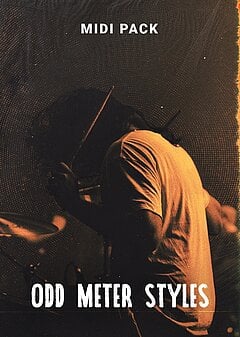How to Inject Life into Dead Drum Beats
Simple layering and processing techniques to revive any acoustic groove and give it the larger-than-life energy you need.
OCTOBER 2ND, 2022
Sample layering and manipulation
In traditionally non-electronic genres like rock and even gospel, there’s been a trend toward layering electronic drums into these arrangements for some time now. In some “acoustic” songs, the kick and snare sound completely electronic, such as in Kirk Franklin’s Love Theory.
Understanding the relationship between acoustic and electronic samples is key to adding life to your drums and making your arrangements sound larger than life. One of the most powerful uses of this is layering the transient or attack of drum samples on top of each drum hit to give this more cut through and punch. To do this effectively, it’s essential to strip out everything but that initial hit until nothing more than a short click is left. All you need to do is drag a sample into your session, shorten it and create a quick fade out on the end. You can apply this process to snares, kicks, toms, any drums where you want to beef up the transients! This doesn’t work nearly as well for cymbals, however, as they can become harsh very quickly.
To help inflate the body of the drums, say if each hit quickly falls flat, you can adjust this process and fade out and in each sample, controlling the amplitude envelope to match the core drum layer. In this case, you’ll generally want to choose samples that have the qualities you’re missing in the core layer — warmth, roundness, roominess, crackle, whatever it might be. Choose complementary samples that have different strong points as opposed to extremely similar ones, otherwise the end result may be weak and even have phase issues, both which will make things very difficult to mix.
Saturate
Once you’ve done all your sample manipulation and lined up the note timings perfectly so it only sounds like a single set of drums (correct drum layering happens when the listener can’t even tell it’s happening!), now it’s time to process the core drums and your added layers together to really lock everything in. Processing everything as a group means that the different layers influence the effects differently than if they were only processed in isolation, making the entire drum group “move” with the effects and bring everything together cohesively. There are a few types of effects that provide the sort of glue we’re looking for.
First on the list is saturation; to understand why this is so critical, think about an electric guitar solo with a harmony part supporting it. This is always done with two guitars, not just due to the difficulty of playing two parts at once, but because the sound is much cleaner when the parts are played on two separate instruments (through two separate amps, cabinets and sets of effects) at the same time.
On one guitar only, this style of solo would become a garbled mess. The more harmonic complexity in the signal that feeds into the saturator, the more aggressive the result becomes. With drums, we want that extra dirtiness — it helps eliminate the separation between the core layer and additional layers while making everything fuller and richer! Depending on the style of saturation you want, both Finisher RETRO and Soundtoys’s Decapitator are fantastic options for this.
Compress
The other effect you’ll want to use extensively to blend drum layers together is compression. “SSL-style” compressors are a staple for processing drum busses and have a punchy, responsive feel that glues things together nicely. This is how Ableton Live’s Glue Compressor gets its name, and is actually made by a company called Cytomic (if you’re working in a different DAW, you can get what is essentially the same compressor separately, called The Glue) — there are tons more compression options available as well.
To lock the transients together, it can help to have one compressor with a very short attack tapping them down slightly, followed by a compressor with a longer attack and heavier gain reduction. A short release will allow the compressor to “ride” the drums more and create an explosive sound, and applying this after saturation will really help your drums come to life! At the end of the chain, you can also use a tiny bit of limiting to tame the transients further and make everything easier to mix down the line. If you want to learn more about compression, you can use our article The Ultimate Guide to Compression to get up to speed!
Final touches
Once the sound finally has the energy and uniformity you’re looking for, it’s time to place everything in the context of the mix with reverb. If no reverb quite seems to do the job for you and you want to give more life to the glow around the drums, you can actually saturate the reverb as well! You’ll be adding much less than when applying it to the drums directly, just a hint — but done right, that tiny amount can be enough to really bring things to life. Many producers miss this opportunity completely, but remember: There’s nothing stopping you from applying effects to the reverb as well! You just need a light touch.
Everything above becomes much easier when you automate the entire process, of course — when the layering between core drums and additional, heavily processed samples is synchronized and doesn’t involve never-ending effect chains. That’s exactly what we designed Virtual Drummer HOT to do: seamlessly blend great acoustic drum samples into punchy drums filled with power and life, with the ability to dial in the exact amount of this effect you want. If this larger than life style is exactly what you need and you want to get the most out of HOT, check out our article, How to Process Drums for Pop Music!
Wrapping up
There are tons of ways to process drums to inject life into even the flattest grooves, but the best approach is often the simplest one: Find samples to layer, multiple per hit if necessary, shape them, process them together with the core groove and use room reverb to give it all a nice glow. This process can take time, but if you want total control over your drums it can be well worth the effort.
Of course, if you want a consistently professional result and to make the process of getting there as seamless as possible, Virtual Drummer HOT will give you exactly what you need every single time — and you’ll never have to worry about your drums lacking in life!
About the Author
Harry Lodes is a copywriter, marketing consultant and content writer for audio and ecommerce brands. He lives in the Philadelphia area, releasing Eastern/Western hybrid EDM under the artist name KAIRI hearkening back to his roots in Berklee College of Music.
Stay Up To Date
Sign up and we’ll send you an e-mail with product news and helpful stuff every now and then.
Defy Limits
We develop software solutions that enable people to create, consume and interact with music.




